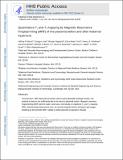Quantitative T1 and T2 mapping by magnetic resonance fingerprinting (MRF) of the placenta before and after maternal hyperoxia
Author(s)
Stout, Jeffrey N; Liao, Congyu; Gagoski, Borjan; Turk, Esra Abaci; Feldman, Henry A; Bibbo, Carolina; Barth, William H; Shainker, Scott A; Wald, Lawrence L; Grant, P Ellen; Adalsteinsson, Elfar; ... Show more Show less
DownloadAccepted version (789.3Kb)
Publisher with Creative Commons License
Publisher with Creative Commons License
Creative Commons Attribution
Terms of use
Metadata
Show full item recordAbstract
INTRODUCTION: MR relaxometry has been used to assess placental exchange function, but methods to date are not sufficiently fast to be robust to placental motion. Magnetic resonance fingerprinting (MRF) permits rapid, voxel-wise, intrinsically co-registered T1 and T2 mapping. After characterizing measurement error, we scanned pregnant women during air and oxygen breathing to demonstrate MRF's ability to detect placental oxygenation changes. METHODS: The accuracy of FISP-based, sliding-window reconstructed MRF was tested on phantoms. MRF scans in 9-s breath holds were acquired at 3T in 31 pregnant women during air and oxygen breathing. A mixed effects model was used to test for changes in placenta relaxation times between physiological states, to assess the dependency on gestational age (GA), and the impact of placental motion. RESULTS: MRF estimates of known phantom relaxation times resulted in mean absolute errors for T1 of 92 ms (4.8%), but T2 was less accurate at 16 ms (13.6%). During normoxia, placental T1 = 1825 ± 141 ms (avg ± standard deviation) and T2 = 60 ± 16 ms (gestational age range 24.3-36.7, median 32.6 weeks). In the statistical model, placental T2 rose and T1 remained contant after hyperoxia, and no GA dependency was observed for T1 or T2. DISCUSSION: Well-characterized, motion-robust MRF was used to acquire T1 and T2 maps of the placenta. Changes with hyperoxia are consistent with a net increase in oxygen saturation. Toward the goal of whole-placenta quantitative oxygenation imaging over time, we aim to implement 3D MRF with integrated motion correction to improve T2 accuracy.
Date issued
2021Department
Massachusetts Institute of Technology. Department of Electrical Engineering and Computer Science; Massachusetts Institute of Technology. Institute for Medical Engineering & ScienceJournal
Placenta
Publisher
Elsevier BV
Citation
Stout, Jeffrey N, Liao, Congyu, Gagoski, Borjan, Turk, Esra Abaci, Feldman, Henry A et al. 2021. "Quantitative T1 and T2 mapping by magnetic resonance fingerprinting (MRF) of the placenta before and after maternal hyperoxia." Placenta, 114.
Version: Author's final manuscript